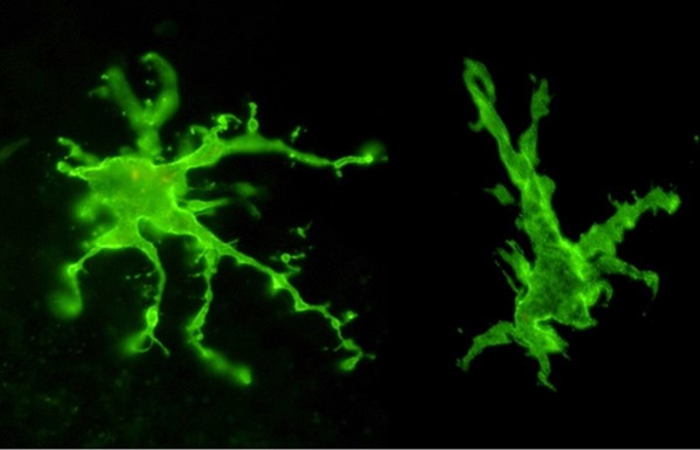Amsterdam, NL, November 16, 2021 – Neuroimmune interactions are emerging as key regulators of brain plasticity throughout life and in both health and disease, but much remains to be discovered. In this special issue of Brain Plasticity experts review our present understanding of the critical role of neuroimmune communication and discuss “taming the storm” in the pathogenesis of psychological disorders. The mechanisms discussed herein may have implications for long- haul mental health disorders exhibited by COVID-19 survivors.

Credit: Tal Burstyn-Cohen.
Amsterdam, NL, November 16, 2021 – Neuroimmune interactions are emerging as key regulators of brain plasticity throughout life and in both health and disease, but much remains to be discovered. In this special issue of Brain Plasticity experts review our present understanding of the critical role of neuroimmune communication and discuss “taming the storm” in the pathogenesis of psychological disorders. The mechanisms discussed herein may have implications for long- haul mental health disorders exhibited by COVID-19 survivors.
Research over the last five decades has consolidated our understanding of the critical roles of neuroimmune communication in the maintenance of homeostasis and in the pathogenesis of peripheral and central nervous system related diseases.
“In vital peripheral organs, hyper-expression of proinflammatory cytokines after viral infection such as COVID-19 often results in significant immune mediated damage, turning the body’s defense mechanism into a cause of its demise,” explained Guest Editors Tal Burstyn-Cohen, PhD, Institute for Oral and Biomedical Research (IBOR), Faculty of Dental Medicine, The Hebrew University, Jerusalem, Israel; and Ning Quan, PhD, Department of Biomedical Science, Charles E. Schmidt College of Medicine, Stiles-Nicholson Brain Institute, Florida Atlantic University, Jupiter, FL, USA. “The survivors of COVID-19 also show long-haul mental health disorders, likely caused by the long lasting secondary cytokine storm that ensues in the central nervous system – reflected in the title of this special issue.”
Content highlights:
Ruth M. Barrientos, PhD, and Stephanie M. Muscat, PhD candidate, both of The Ohio State University, review accumulated evidence for the “perfect cytokine storm” that explains how immune activation initiated in the periphery might sensitize microglial cells of the brain to translate peripheral cytokine storm into a central menace, especially in the elderly. Behind the usually protective blood brain barrier, microglial senescence, high-fat diet, surgical trauma, oxidative stress, psychological stress, and compromised blood brain barrier prime the vulnerability of the central nervous system, allowing a significant peripheral infectious event to tip the system into a prolonged state of dysfunction.
Ning Quan, PhD, Florida State University, and Daniel P. Nemeth, BS, The Ohio State University, provide an update on the current understanding of a crucial cytokine in this brain cytokine storm, interleukin-1 (IL-1), which modulates neural networks. Distinct neuroimmune effects mediated by IL-1 can now be analyzed on a cell type-specific basis, heralding in new paradigms to explain how this pivotal cytokine might regulate neural network activity.
Tal Burstyn-Cohen, PhD, and Arielle Hochberg, MSc, both of The Hebrew University, review the multifarious roles fulfilled by Tyro3, Axl and Mertk (known collectively as TAM) receptors when the central nervous system experiences a cytokine storm and also under the calmness of healthy homeostasis. Expressed by microglia – the immune cells of the central nervous system – TAMs perform bona fide immune-related roles as regulation of inflammation and cytokine secretion both in health and in disease. An overview of the recent studies examining the roles of TAM-signaling molecules in disease includes models of Alzheimer’s and Parkinson’s disease, ischemia, and multiple sclerosis.
Alexander D. Walsh, PhD candidate, The Florey Institute of Neuroscience and Mental Health, and colleagues take a closer look into the transcriptional regulation of the TAM receptor MERTK. MERTK expression is enriched in the central nervous system and in resident innate immune cells where it regulates numerous functions that support brain plasticity. Polymorphisms in the MERTK gene are associated with multiple sclerosis. These data may advance strategies to therapeutically intervene and regulate MERTK transcription in various disease states to tailor inflammatory signaling and efferocytosis, which may affect multiple aspects of brain plasticity.
“Two emerging areas are in the field are direct modulation of neural circuitry via cytokine receptors expressed on neurons and the impact of immunosuppressive signaling on neuronal functions,” noted Dr. Quan. “Scientists must carefully examine how immune system molecules operate in the brain because entirely new modalities might exist for these molecules to exert different functions in the brain. Understanding these issues is highly important at this time as we learn that immune response, for example towards COVID-19, could profoundly influence mental health even after the patients have recovered from the infection.”
“Immune cells are active players in brain physiology, but much remains to be discovered about the effects of the immune cells on brain plasticity, how systemic immune signals are interpreted and sensed by the brain, and how these affect brain function,” added Dr. Burstyn-Cohen.
Looking forward, the field is still lacking good markers to distinguish between brain and circulating immune cells, especially to distinguish between microglia and peripheral monocytes/macrophages in cases where the blood-brain barrier is breached. Research also needs to improve in vivo monitoring of immune status and develop non-invasive early detection of disease and inflammatory markers. “We hope the articles in this issue help us to continue this journey,” concluded the Guest Editors.
Method of Research
Commentary/editorial
Subject of Research
Not applicable
Article Title
Special Issue: The Immune System and Brain Function
Article Publication Date
16-Nov-2021




